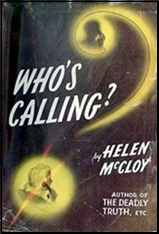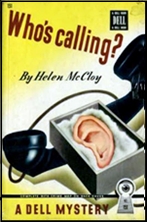Tue 1 Aug 2023
A Golden Age Mystery Review: HELEN McCLOY – Who’s Calling?
Posted by Steve under Reviews[11] Comments

HELEN McCLOY – Who’s Calling? Basil Willing #4. William Morrow, hardcover, 1942, Dell #151, mapback edition [1947]; cover art by Gerald Gregg.
Dr. Basil Willing, Helen McCloy’s primary (and only) series character appeared in thirteen novels between 1938 and 1980, and at least two short stories. Willing may have the distinction of being the first psychiatrist detective, having a formal connection with the NYPD and perhaps as well with the FBI, and being called upon to help solve cases in which his professional knowledge might come in handy.
This one begins with a voice on the telephone warning New York night club singer Freda Frey not to accompany her fiancé Archie Cranford down to meet his mother who lives in a small town outside of Washington DC. She goes anyway, in spite of the phone call and in spite of an unspoken hostility from her future mother-in-law, who fears that Archie will settle for less in his life if he marries her.
Freda is not the victim of a killer, however. Dead instead is Chalkley Winchester, a long lost cousin of Mrs, Cranford and the fussy kind of a man that reminded me of Truman Capote, say, but several years before the latter’s time.

Working on a degree is psychiatry himself, it is Archie who calls in Dr. Willing to help the police, an event that doesn’t occur until perhaps a third of the way through the book, and it is his expertise that helps determine that the killer is suffering from a split personality disorder. What may make this mystery unique in the annals of detective fiction is that while Willing nor the police know who the killer is, neither does he or she as well.
I confess I do not know why the killer was continually referred to as a poltergeist. As I understand the term, that is a undead spirit which manifests itself by making noises in the night and throwing crockery against the wall.
Setting aside most of the psychiatric background of the case as only pleasant background noise,, which I did, this is a well-constructed detective puzzle in which all of pieces fit snugly together at the end, against a backdrop of upper middle-class gentility that not so incidentally is part of the killer’s motivation, a nice touch. Not a work of classic stature, say, but it’s one that will do until one of that magnitude comes along.
August 1st, 2023 at 2:47 am
I have always enjoyed her work. Despite being named an MWA Grand Master in 1990, she is unjustly overlooked today.
August 1st, 2023 at 3:07 am
One thing I should have said in my review and I should have, is that she was a very good writer, not just the mystery aspect, but in terms of her descriptive style and her dialogue. Both are top notch. You’re right. She’s forgotten today, and that’s a shame.
My review of DO NOT DISTURB:
https://mysteryfile.com/blog/?p=46925
My review of CuE FOR MURDER:
https://mysteryfile.com/blog/?p=45328
Bob Briney’s review of CUE FOR MURDET:
https://mysteryfile.com/blog/?p=32003
August 1st, 2023 at 3:31 am
Poltergeists were often associated with disturbed people – often adolescents – as a form of unconscious “psychic projection” or physical mischief-making, so reference to a “split personality” isn’t inappropriate.
August 1st, 2023 at 1:12 pm
A tenuous connection to me, Roger, in terms of the story, but you’re on the right of it. It’s the best explanation I’ve come up with, too. I think that McCloy would have been better off sticking to the premise of a split personality disorder, which fits perfectly fine. But she often added hints of the supernatural to her mysteries, and this was her way of doing that in this one.
August 1st, 2023 at 1:14 pm
And FYI, in case anyone might be wondering, the cover of the Dell mapback is a fraud. There is no severed ear in a box in the story.
August 1st, 2023 at 1:41 pm
For severed ear afficianados, Blue Velvet’s intrigues begin with such. Mike Tyson’s a fan.
August 1st, 2023 at 4:58 pm
Severed ears? My Gogh!
Anyway, Helen McCoy gets my vote for most cute-as-a-button mystery authoress. She’s certainly an impish-grinning pixie in those ’40s photos.
August 2nd, 2023 at 1:02 pm
I read one of the Basil Willing novels many years ago and remember enjoying it quite a bit. Don’t know why I never read any more of them. I should. I also have to mention that McCloy was married to Davis Dresser from 1946 to 1961, and they founded Torquil Books, which published not only Dresser’s Mike Shayne books from that era but also some genre fiction by other authors. Torquil was distributed by Dodd, Mead, I believe.
August 2nd, 2023 at 3:33 pm
Thanks, James, and as a quick follow-up, just in case someone doesn’t know, Davis Dresser is best known as the first Brett Halliday, with several others using the byline later on (with active consent) for the full run of Mike Shayne novels and stories.
August 2nd, 2023 at 7:06 pm
Willing covered a lot of territory from the near, or at least suspected supernatural, to spy fiction. Frank McSherry named THROUGH A GLASS DARKLY as one of the premiere examples of what he called the Janus Solution where the mundane solution was played equal to the supernatural one as in Carr’s THE BURNING COURT.
August 3rd, 2023 at 5:21 pm
Now I remember that THROUGH A GLASS DARKLY is the one I read. I recall really liking it.